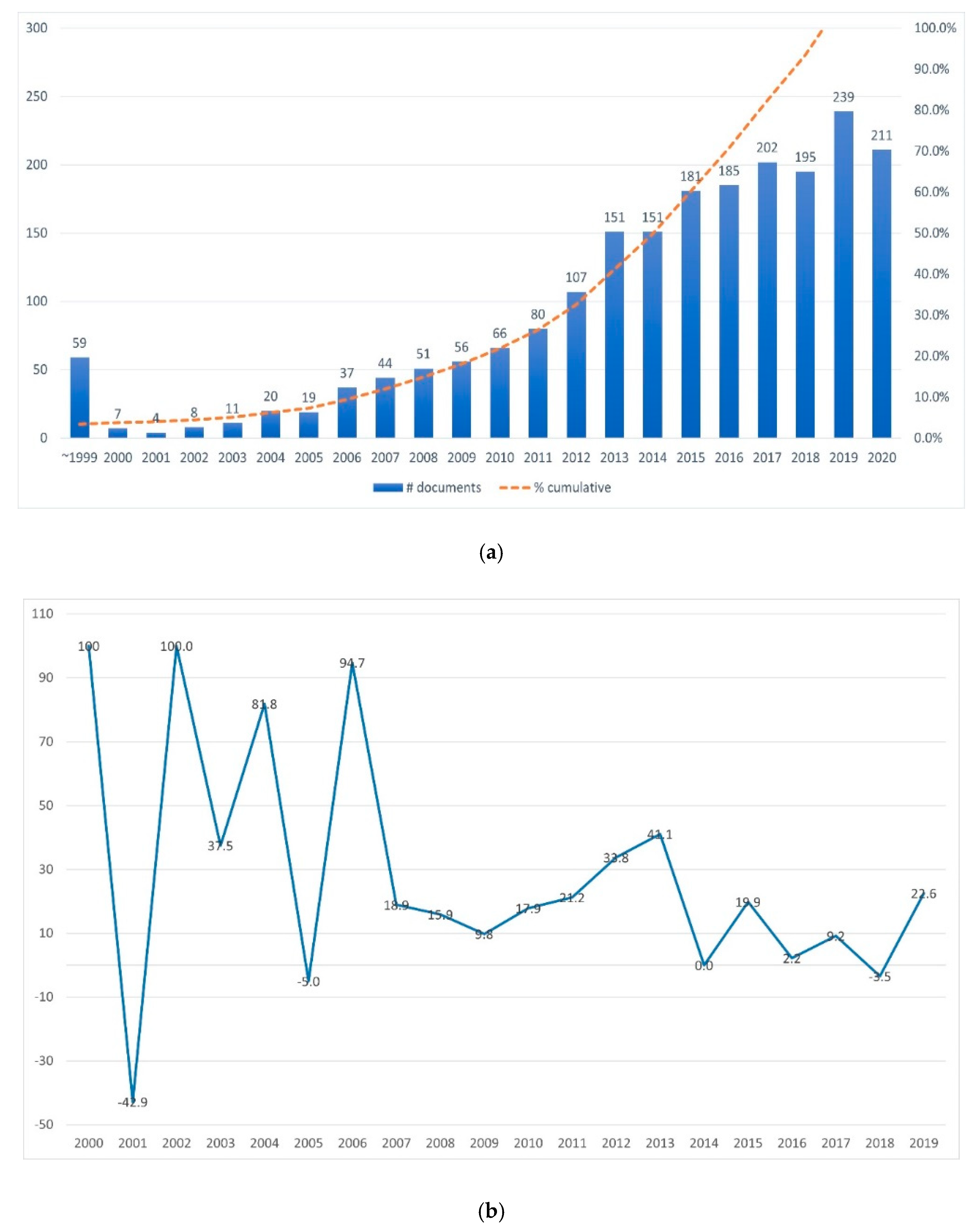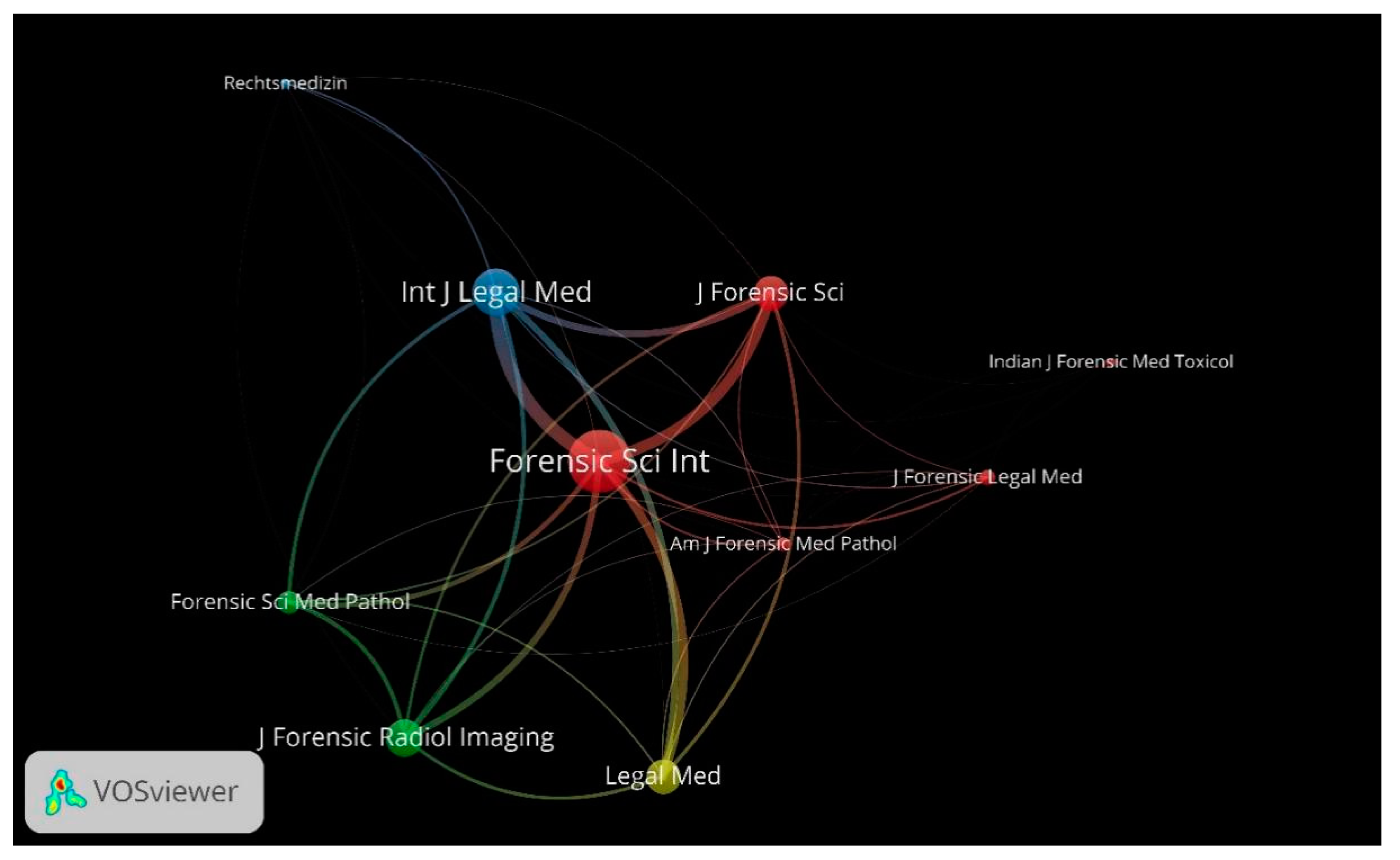2. Materials and Methods
The Scopus indexed articles were searched using the
Document Search function [
8] on 4 November 2020. Four terms—“forensic” OR “medicolegal” OR “legal medicine” AND “computed tomography”—were used for document search so that any articles containing one of the three pairs of keywords (i.e., “forensic—computed tomography”, “medicolegal—computed tomography”, or “legal medicine—computed tomography”) in their title, abstract, and/or keywords could be detected. Document type was limited to “Articles and Reviews” so other types of publications such as book chapters, letters, conference papers, and surveys were excluded. The years of publication were not specified, and Ostertag et al.’s [
9] work titled “Diagnostic possibilities of computerized tomography in forensic examination of cerebral traumatized persons” was marked as the earliest article. The citation information (e.g., authors, title, publication year, citation counts, and source), bibliographic information (e.g., affiliations and correspondence address), abstract and keywords, and reference information of all selected articles were exported in a comma-separated values (CSV) file format for further analyses. Informed consent was not required from the authors of the articles because the data were collected as secondary data lacking personal information.
Microsoft Excel was used to calculate descriptive statistics and annual growth rate (AGR) and to produce related plots. AGRs were calculated as follows, which represents the percentage rate of positive or negative growth of a product in a certain year compared to the previous year [
10].
where
: number of documents in the year
i.
In calculating AGRs, only the articles published between 2000 and 2019 were included, during which drastic increase in publications was observed. The publications in 2020 were excluded from the AGR calculation because the number of publications at the time of data collection for this study could not represent that of the entire year.
VOSviewer 1.6.15 [
11] was used for bibliometric analysis. VOSviewer is an open source computer program which makes it possible to perform bibliometric analyses and display two-dimensional maps based on the co-occurrences of the nodes/subjects [
12]. One of the advantages of using VOSviewer for this purpose is that VOSviewer can analyze the bibliometric data exported from the major journal archives such as Scopus, Web of Science, and PubMed directly.
4. Discussion
Bibliometric analysis allows for a quantitative, systematic, and objective assessment on the publications in a field, which helps researchers to have an understanding about the past and current state of the field as well as a holistic insight on its future direction [
6,
7,
10]. Among the earliest topics for the bibliometric analyses was forensic science where the publications of diverse subdisciplines of forensic science in Europe were examined [
13,
14]. The establishment of digital journal archives (e.g., Scopus, Web of Science, and PubMed) and development of computer software that can analyze the archived data (e.g., VOSviewer) makes the process of bibliometric analysis straightforward and time-efficient. Thus, recent years have seen increasing bibliometric analyses in various fields, e.g., [
6,
7,
15,
16].
One of the notable findings in the current study is the rapid increase in the number of articles, particularly since the early 2000s (
Table 1). In 2003, Thali and colleagues [
4] emphasized and encouraged the utility of imaging techniques such as CT and MRI in the field of forensic science. Interestingly, this year was the first year during which more than ten CT-related forensic articles were published (
n = 11), and the increasing trend has continued except for 2005, 2014, and 2018. The AGR has fluctuated between 2000 and 2019; however, except for 2001, 2005, and 2018, there were no years with negative AGRs. In other words, the number of publications for most of the past 20 years exceeded (or was the same as) that of the preceding year (
Table 1). In 2017, the number of annual publications exceeded 200 for the first time (
n = 202) and the increasing trend is likely to continue in 2020 as well (
n = 211 as of 4 November 2020).
Switzerland and United States ranked first and second in both the number of publications (
n = 335 and
n = 259, respectively) and citations (
n = 6662 and
n = 4775, respectively) (
Table 2). Japan ranked third in the number of publications (
n = 224), but Germany ranked third in terms of the number of citations (
n = 3534). Cluster analysis in
Figure 3 shows which countries have close collaborative relationships. Demir et al. [
6] state that geographic location is an important factor in terms of collaborations between countries. However, the result of the current study did not show a clear relationship between the geographic locations and collaborative network of the countries. For example, eight European countries in
Figure 3 were divided into four different clusters, and China and France were in the same cluster. It is beyond the scope of the current study to investigate the underlying factors affecting the international collaborations, but it would be a significant topic for future research.
The leading role of Switzerland in the CT-related forensic studies was also evident in the list of most productive institutions (
Table 4). Six out of 16 institutions in
Table 4, including the top three institutions, are located in Switzerland. Moreover, approximately 23.8% of the articles (496 out of 2084) have been produced by these six Swiss institutions. The rest of the institutions are located in Australia, China, France, Germany, Japan, and the United Kingdom. Interestingly, any institutions from the United States or Italy, which ranked second and sixth in the number of publications, were not listed in
Table 4. This is possibly because the large number of publications in the United States (
n = 259) and Italy (
n = 173) have been produced by diverse research groups rather than by a small number of leading groups.
Approximately 43.6% of the CT-related forensic studies (909 out of 2084 articles) have been published in five journals (Forensic Science International, International Journal of Legal Medicine, Journal of Forensic Radiology and Imaging, Journal of Forensic Sciences, and Legal Medicine) with the total number of citations of 13,836 (
Table 5). Forensic Science International ranked first in both the number of publications (
n = 261) and number of citations (
n = 5241). Indeed, the co-citation analysis map in
Figure 4 displays the Forensic Science International in the center, which indicates that the articles in the journal have been cited by most of the other journals. Similar results were obtained from previous bibliometric studies in the fields of legal medicine [
6] and forensic anthropology [
16], where Forensic Science International was listed as the most influential journal.
The keyword analysis revealed four clusters, of which centers (i.e., the keywords with the greatest total link strength of each cluster) were “Forensic Anthropology”, “Postmortem Computed Tomography”, “Autopsy”, and “Computed Tomography”. This result indicates that CT has been primarily used in two forensic subfields: forensic pathology/medicine and forensic anthropology. Since the development of X-ray CT in 1974, the CT technique has been constantly applied to forensic pathological studies and case reports [
9]. The continuous effort to develop advanced techniques at higher resolution has led to a more common application of virtual autopsy (virtopsy) in medical examiners’ offices nowadays [
17,
18]. This trend not only resulted in a plentiful production of articles to validate the utility of CT compared to traditional autopsy or other types of imaging techniques, e.g., [
19,
20,
21], but also expanded the applicability of CT (e.g., estimation of pupae’s developmental age [
22]; reconstruction of bloodstain in fabric [
23]; determination of non-human skeletal remains [
24]). Recently, the need to establish new and efficient processing protocols has increased in the field where CT is applied, e.g., [
25]. In the field of forensic anthropology, the CT technique has been introduced relatively recently as shown in the keyword analysis (
Figure 5); however, the number of forensic anthropological studies using CT has increased rapidly. Particularly, there has been increasing efforts to develop new models for sex and age estimation using CT, e.g., [
26,
27,
28], to validate the accuracy of osteometric measurements in the CT scans, e.g., [
29,
30], and to automate the analysis processes where CT is involved, e.g., [
31,
32]. In addition, Cone Beam CT has been frequently used to measure the thickness of facial soft tissues and contributed to the field of facial reconstruction and personal identification, e.g., [
31,
33].
As to the application of VOSviewer for a bibliometric analysis, Demir et al. [
6] pointed out two limitations which the current study could also not avoid: a risk of self-citation and a risk of excluding publications written in a non-English language from the analyses. In addition, since the scope of publications analyzed by VOSviewer is determined primarily by the keywords entered during the Document Search process, there is a possibility that a bibliometric study may not include all publications of a targeted field. To avoid this issue, a careful selection of keywords will be required. In this regard, this study used four keywords (“forensic”, “legal medicine”, “medicolegal”, and “computed tomography”) to include as many related publications as possible. Lastly, some information presented by VOSviewer may slightly differ from what they actually are because VOSviewer analyzes data as the authors of the original publications literally provided. For example, if an author working in a university hospital used the names of the university and the hospital in two different papers as his/her affiliation, there is no way for VOS viewer to notice it. A careful inspection and verification of the information as well as an effort to avoid these limitations will be necessary in the future research.










